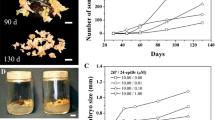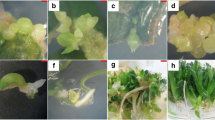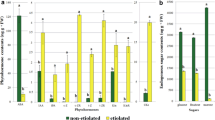Abstract
Leaf explants of two Phalaenopsis, P. amabilis and P. Nebula, were used to test the effects of auxins (2,4-D, IAA, IBA, NAA), cytokinins (2iP, BA, kinetin, TDZ, zeatin), GA3, ancymidol, polyamines (putrescine, spermine, spermidine), ACC, AgNO3 and CoCl2 on the amount of direct embryo formation on different leaf locations (the cut end, the adaxial side, the abaxial side and the leaf tip). The results showed that there was a genotypic effect on direct embryo formation induced by cytokinins that 13.32 μM BA and 4.92 μM 2iP was the most effective in P. amabilis and P. Nebula, respectively. Besides, explant position highly affected embryogenic competence of leaf cells in both species that the cut end showed highest embryogenic response, the adaxial side was the second, and then the abaxial side and the leaf tip. Altogether, cytokinins tested were all effective in both species, and ACC at 20 μM had 35% of embryogenic response in P. amabilis. However, auxins, GA3, ancymidol and polyamines were inhibitory in both species.
Similar content being viewed by others
Avoid common mistakes on your manuscript.
Introduction
Phalaenopsis orchids have highly economical value for cut flower and pot plant production in international flower markets. The conventional in vitro culture protocols had been developed in this genus and usually for the propagating purpose via protocorm-like body formation, shoot multiplication and callus culture (Tanaka et al. 1975; Arditti and Ernst 1993; Tokuhara and Masahiro 1993; Ernst 1994; Chen and Piluek 1995; Duan et al. 1996; Ishii et al. 1998; Islam and Ichihashi 1999; Chen et al. 2000; Young et al. 2000; Tokuhara and Mii 2001; Park et al. 2002). Recently, more efficient regeneration systems through direct somatic embryogenesis had been developed using leaf cultures (Kuo et al. 2005; Chen and Chang 2006). However, further systematic investigations on culture condition, medium composition and physiological status are needed to optimize the protocol for practical use in regenerating transgenic plants or mass propagation in this orchid. In this report, the leaf culture system of Phalaenopsis was used to study the effects of growth regulators on direct somatic embryogenesis.
Materials and methods
Two Phalaenopsis orchids were used in this study, Phalaenopsis amabilis Shimadzu var. formosa with large white flowers (the most beautiful native orchid species in Taiwan) and P. Nebula (one of the most popular commercial cultivar). In-vitro-grown plants of P. amabilis were purchased from Taiwan Sugar Corporation (TSC), Taiwan. While the seedlings of P. Nebula were collected by in vitro seed germination followed the protocol described by Chen and Chang (2006). The basal medium is 1/2-strength modified Murashige and Skoog (1962; 1/2 MS) medium containing half-strength macro- and micro-elements supplemented with myo-inositol (100 mg/l), niacin (0.5 mg/l), pyridoxine HCl (0.5 mg/l), thiamine HCl (0.1 mg/l), glycine (2 mg/l), peptone (1 g/l), NaH2PO4 (170 mg/l), sucrose (20 g/l) and Gelrite (2.2 g/l). Plant growth regulators were added according to the experimental design and the pH of the media was adjusted to 5.2 with 1 M KOH or HCl prior to autoclaving for 15 min at 121°C. The plants were maintained with a 2-month-interval subculture period on a hormone-free 1/2 MS medium in 250 ml flasks under a 16-h photoperiod at irradiance of 28–36 μmol m−2 s−1 (daylight fluorescent tubes FL-30D/29, 40 W, China Electric Co., Taipei, Taiwan) and temperature of 26 ± 1°C. The seedlings with three to five leaves and two to four roots were used as donor plants.
Leaf tip segments (about 1 cm in length) taken from the donor plants were used to induce direct somatic embryogenesis on a 1/2 MS basal medium supplemented with growth regulators as the experimental design. The leaf explants of two genotypes (P. amabilis, P. Nebula) were placed adaxial-side-up on the culture medium and were incubated in 90 × 15 mm2 Petri dishes under darkness for 2 months. Growth regulators including auxins (2.26, 4.52 and 13.57 μM 2,4-D; 2.85, 5.71 and 17.13 μM IAA; 2.46, 4.92 and 14.76 μM IBA; 2.69, 5.37 and 16.11 μM NAA), cytokinins (types and concentrations were shown in Tables 1, 2), GA3 (2.89, 7.22 and 14.44 μM), ancymidol (3.90, 9.75 and 14.44 μM), polyamines (11.34, 28.36 and 56.72 μM putrescine; 4.94, 12.36 and 24.71 μM spermine; 6.88, 17.21 and 34.42 μM spermidine), ACC, AgNO3 and CoCl2 (concentrations were shown in Table 3) were used to test their effects on the amount of direct embryo formation from different locations (LT: leaf tips; Ad: adaxial sides; Ab: abaxial sides; CE: cut ends) on leaf explants. Five replicates (dishes) each with four leaf explants were performed for each treatment.
The percentage of explants forming somatic embryos was recorded as formed from entire explants or different locations of the explants. The number of embryos formed from each responding explant was counted under a stereomicroscope (SZH, Olympus, Tokyo, Japan) at the protocorm stage. Data expressed as percentage were transformed using arc sine prior to ANOVA and converted back to the original scale (Compton 1994). Treatment means were compared by following Duncan’s Multiple Range Test (Duncan 1955).
Results and discussion
Effects of auxins
Leaf explants of P. amabilis formed small transparent granules from cut ends in all of the auxin treatments, but these granular structures failed to further develop. Severe browning was found on all explants especially on 2,4-D-containing medium. In fact, almost all the explants became necrotic after 2 months of culture. In the previous report by Kuo et al. (2005), it was found that leaf explants became necrotic and no embryos were obtained when cultured on medium supplemented with 0.45–4.52 μM 2,4-D. Besides, exogenous auxins also played an inhibitory role in direct embryo formation of Oncidium and Dendrobium (Chen and Chang 2001; Chung et al. 2005, 2007). In P. amabilis, Chen and Chang (2006) had reported that NAA retards direct embryo formation from leaf explants and reduced the amount of embryos induced by TDZ. Another work by Kuo et al. (2005) in Phalaenopsis “Little Steve”, 2,4-D showed highly inhibitory in direct embryo induction from leaf explants even in the presence of TDZ. The present result showed that four kinds of auxins (including 2,4-D, IAA, IBA and NAA) all highly retarded direct embryogenesis from leaf explants of P. amabilis.
Effects of cytokinins
Working with P. amabilis, TDZ promoted repetitive embryogenesis from zygotic protocorms (Chen and Chang 2004), and induced a higher frequency of embryogenesis from leaf explants (Chen and Chang 2006). In P. “Little Steve”, TDZ induced a higher frequency of embryogenesis from leaf explants than BA and kinetin (Kuo et al. 2005). In this present study, Table 1 shows effects of different cytokinins on direct embryo formation from leaf explants of P. amabilis. Except for the control treatment, all of cytokinin tested had embryogenic response after 2 months of culture. The highest percentage of embryogenesis (80%) was found at 13.32 μM BA, while the highest number of embryos per explant was 7.8 at 13.62 μM TDZ (Table 1). Altogether, BA at 13.32 μM had the highest enhancement on the amount of direct embryogenesis (80% of embryogenesis × 6.6 embryos per explant) than other cytokinins (Table 1). Leaf position could affect direct embryogenesis, and different locations showed distinct ability to form embryos (Table 1). The cut ends had highest embryogenic competence and adaxial sides were the second (Table 1). By contrast, abaxial sides and leaf tip locations only formed a small numbers of embryos (Table 1).
In P. Nebula, the highest percentage of embryogenesis and number of embryos per explant were at 13.62 μM TDZ and 4.65 μM kinetin, respectively (Table 2). Altogether, 4.92 μM 2iP had the highest response on the amount of embryogenesis (60% of embryogenesis × 8.8 embryos per responding explant) than other cytokinins (Table 2). Obviously, there was a genotypic effect on the type and concentration of cytokinin using in direct embryo induction (Tables 1, 2). A position effect was also effective in P. Nebula, the order of locations’ embryogenic competence was almost the same with P. amabilis as the cut end, the adaxial side was the second, and then the abaxial side and the leaf tip (Table 2). Both in two species, the cut end had the best embryogenic response than other leaf locations (Tables 1, 2). However, in Oncidum leaf cultures, the leaf tip had a highly embryogenic competence than the cut end and other locations (Chen et al. 1999; Chen and Chang 2001). Further investigations on more species are needed to verify the difference in position effects between Phalaenopsis and Oncidium leaf cultures.
Effect of GA3 and ancymidol
Leaf cultures of P. amabilis showed no embryogenic response in all of the GA3 and ancymidol treatments. Although occasionally a small number of transparent granules was found on cut ends of explants. All of these protuberances failed to develop and became necrotic with the parental explants eventually after 2 months of culture.
Effects of polyamines
Except for one explant formed a single embryo at 11.34 μM putrescine, all of the polyamine treatments resulted in no embryogenic response from leaf cultures of P. amabils.
Effects of ACC, AgNO3 and CoCl2
In P. amabilis, ACC at 20 μM significantly induced 35% of leaf explants to form 10.6 embryos per explant (Table 3). However, there were no significant effects induced by other treatments of ACC, AgNO3 and CoCl2 (Table 3). In addition, all of the ACC, AgNO3 and CoCl2 treatments had no embryogenic response on leaf cultures of another species, P. Nebula. Further intensive investigations using more genotypes should be performed to clarify the action of ethylene on direct embryo formation in Phalaenopsis.
Plantlet conversion
After 2 months of culture in darkness, embryos (about 2–4 mm in diameter) formed on surfaces of leaf explants (Fig. 1a). These regenerated embryos showed no obvious morphological difference between growth regulator treatments. Embryos further enlarged and formed roots after 4 months of culture (Fig. 1b). Plantlets derived from embryos were successfully established on hormone-free 1/2 MS medium and grew normally (Fig. 1c). After 6 months of culture, several dozens of plantlets were transplanted to sphagnum moss and acclimatized in greenhouse with 100% survival rate (Fig. 1d).
Plant regeneration via direct somatic embryogenesis from leaf explants of Phalaenopsis amabilis on 13.32 μM BA containing medium. a embryos formed on leaf explants after 2 months of culture in darkness (Scale bar 8 mm); b embryos further enlarged and formed roots after subculture on hormone-free 1/2 MS medium for 2 months of culture (Scale bar 5 mm); c an embryo-derived plantlet (Scale bar 10 mm); d a 6-month-old regenerated plantlet acclimatized in greenhouse (Scale bar 25 mm)
In summary, promotion of direct embryo formation could be achieved by adjusting the type and concentration of growth regulators in culture medium. Generally, cytokinins tested were all effective in direct embryo induction of both species, and ACC at 20 μM showed 35% of embryogenic response in P. amabilis. However, auxins, GA3, ancymidol and polyamines were all inhibitory in both species. Besides, genotype and explant position also affect direct embryo induction in Phalaenopsis.
Abbreviations
- 2,4-D:
-
2,4-Dichlorophenoxyacetic acid
- 2iP:
-
N 6-2-Isopentenyl adenine
- ACC:
-
1-Aminocyclopropane-1-carboxylic acid
- BA:
-
N 6-Benzyladenine
- GA3 :
-
Gibberellin A3
- IAA:
-
Indole-3-acetic acid
- IBA:
-
Indole-3-butyric acid
- kinetin :
-
N 6 Furfuryladenine
- MS:
-
Murashige and Skoog (1962) medium
- NAA:
-
1-Naphthaleneacetic acid
- TDZ:
-
1-Phenyl-3-(1,2,3-thiadiazol-5-yl)-urea (thidiazuron)
- Zeatin:
-
6-[4-Hydroxy-3-methylbut-2-enylamino]purine
References
Arditti J, Ernst R (ed) (1993) Micropropagation of orchids. Wiley, New York
Chen JT, Chang WC (2001) Effects of auxins and cytokinins on direct somatic embryogenesis on leaf explants of Oncidium ‘Grower Ramsey’. Plant Growth Regul 34:229–232
Chen JT, Chang WC (2004) Induction of repetitive embryogenesis of Phalaenopsis amabilis var. formosa Shimadzu. In Vitro Plant 40:290–293
Chen JT, Chang WC (2006) Direct somatic embryogenesis and plant regeneration from leaf explants of Phalaenopsis amabilis. Biol Plant 50:169–173
Chen Y, Piluek C (1995) Effects of thidiazuron and N 6-benzylaminopurine on shoot regeneration of Phalaenopsis. Plant Growth Regul 16:99–101
Chen JT, Chang C, Chang WC (1999) Direct somatic embryogenesis on leaf explants of Oncidium ‘Grower Ramsey’ and subsequent plant regeneration. Plant Cell Rep 19:143–149
Chen YC, Chang C, Chang WC (2000) A reliable protocol for plant regeneration from callus culture of Phalaenopsis. In Vitro Plant 36:420–423
Chung HH, Chen JT, Chang WC (2005) Cytokinins induce direct somatic embryogenesis of Dendrobium Chiengmai pink and subsequent plant regeneration. In Vitro Plant 41:765–769
Chung HH, Chen JT, Chang WC (2007) Plant regeneration through direct somatic embryogenesis from leaf explants of Dendrobium. Biol Plant 51:346–350
Compton ME (1994) Statistical methods suitable for the analysis of plant tissue culture data. Plant Cell Tissue Organ Cult 37:217–242
Duan JX, Chen H, Yazawa S (1996) In vitro propagation of Phalaenopsis via culture of cytokinins-induced nodes. J Plant Growth Regul 15:133–137
Duncan DB (1955) Multiple range and multiple F test. Biometrics 11:1–42
Ernst R (1994) Effects of thidiazuron on in vitro propagation of Phalaenopsis and Doritaenopsis (Orchidaceae). Plant Cell Tissue Organ Cult 39:273–275
Ishii Y, Takamura T, Goi M, Tanaka M (1998) Callus induction and somatic embryogenesis of Phalaenopsis. Plant Cell Rep 17:446–450
Islam MO, Ichihashi S (1999) Effects of sucrose, maltose and sorbitol on callus growth of Phalaenopsis, Doritaenopsis and Neofinetia. J Jap Soc Hortic Sci 68:1124–1131
Kuo HL, Chen JT, Chang WC (2005) Efficient Plant regeneration through direct somatic embryogenesis from leaf explants of Phalaenopsis ‘Little Steve’. In Vitro Plant 41:453–456
Murashige T, Skoog F (1962) A revised medium for rapid growth and bioassays with tobacco tissue cultures. Physiol Plant 15:495–497
Park SY, Murthy HN, Paek KY (2002) Rapid propagation of Phalaenopsis from floral stalk-derived leaves. In Vitro Plant 38:168–172
Tanaka M, Hasegawa A, Goi M (1975) Studies on the clonal propagation of monopodial orchids by tissue culture I. Formation of protocorm-like bodies from leaf tissues in Phalaenopsis and Vanda. J Jap Soc Hort Sci 44:47–58
Tokuhara K, Masahiro M (1993) Micropropagation of Phalaenopsis and Doritaenopsis by culturing shoot tips of flower stalk buds. Plant Cell Rep 13:7–11
Tokuhara K, Mii M (2001) Induction of embryogenic callus and cell suspension culture from shoot tips excised from flower stalk buds of Phalaenopsis (Orchidaceae). In Vitro Plant 37:457–461
Young PS, Murthy HN, Yoeup PK (2000) Mass multiplication of protocorm-like bodies using bioreactor system and subsequent plant regeneration in Phalaenopsis. Plant Cell Tissue Organ Cult 63:67–72
Author information
Authors and Affiliations
Corresponding author
Additional information
Communicated by A. K. Kononowicz.
Rights and permissions
About this article
Cite this article
Gow, WP., Chen, JT. & Chang, WC. Influence of growth regulators on direct embryo formation from leaf explants of Phalaenopsis orchids. Acta Physiol Plant 30, 507–512 (2008). https://doi.org/10.1007/s11738-008-0148-4
Received:
Revised:
Accepted:
Published:
Issue Date:
DOI: https://doi.org/10.1007/s11738-008-0148-4





